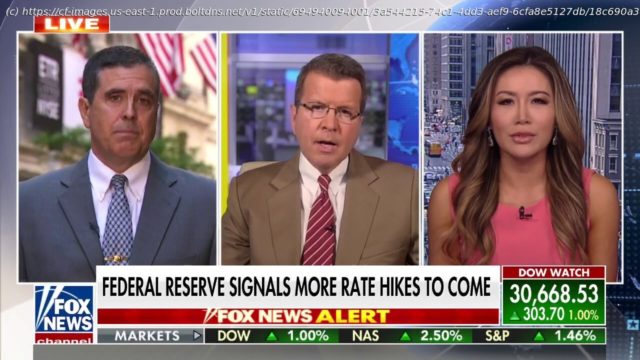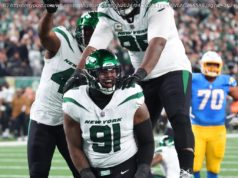This is a rush transcript of “Your World with Neil Cavuto” on June 15, 2022. This copy may not be in its final form and …
This is a rush transcript of “Your World with Neil Cavuto” on June 15, 2022. This copy may not be in its final form and may be updated. NEIL CAVUTO, FOX NEWS ANCHOR: Ready, set, hike. FOX on top of a Fed on fire and a stock market fired up, and all because interest rates today rocketed up. You heard us right, stocks soaring news that borrowing costs are rising. Now, stick with us here, because something very unusual is going on here, the Federal Reserve today hiking a key interest rate by three-quarters-of- a-percentage point. That’s not only unusual. That’s darn near unprecedented. In fact, you would have to go all the way back to 1994 to see anything like it. Back then, Bill Clinton was president, “Forrest Gump” was a box office hit, and police were chasing O.J. Simpson in a white Bronco. This time it’s the Fed chasing something else, not O.J. on the run, but prices out of control. Experts call it getting ahead of the inflation curve, and investors liked what they saw. But will you? After all, your borrowing costs just went up and stand to go up even more. But the hope is that the tough medicine will work and this inflation fever will break. The only question, of course, is when. We have got you covered regardless with Connell McShane at the Nasdaq on why traders are buying the half-full-glass story, the guy They called the Sarge on whether order is returning, Ed Lawrence in Washington with the Fed chief, Jerome Powell, and what he’s predicting, and Gerri Willis in New York on why borrowers are wearing, but savers, will, man, oh, man, they are rejoicing. Welcome, everybody. I’m Neil Cavuto. And this is a much more expensive “Your World”, but for today, at least, rejoicing at the prospect it won’t last very long, at least the high prices. We got to Connell McShane at Nasdaq with more — Connell. CONNELL MCSHANE, FOX NEWS CORRESPONDENT: Well, hey there, Neil. I think investors, more than anything, liked what they heard from the Fed chairman, Jerome Powell, after the decision to hike interest rates. And the message from the chairman essentially boiled down to this: Yes, we know we had to be aggressive today, and we were, but don’t get used to it. It might not be like this forever. So three-quarters-of-a-point higher, yes, that’s a lot, first time since 1994 that we have seen them move like that. But then Powell comes out in his news conference, which you will hear more about in a moment, and he says, this is not going to be common, won’t be common. And after those comments, it seems like the stock market really took off. I want to show you two charts of the Dow Jones industrial average just to kind of illustrate the point of where we have been and maybe where we’re going. I mean, where we have been is important, because it gives us a perspective on today’s rally in the market. The Dow fell, give or take, about 3,000 points in four-and-a-half days coming into today. So it was way down. At the end of that chart, we start to come back. If we zoom in and make that a one-day chart, just today, of the Dow Jones industrial average, then you get the Fed market reaction. At first, it was a bit muted at 2:00 p.m. Eastern time, but then, with those comments from Powell that this will not be a common occurrence, and, at the next meeting, he will be choosing between going at half-a-point or three-quarters-of-a-point, the market really shot up on that. I think tech stocks, and not just because we’re here at the Nasdaq today, but just in general tech stocks are a really good place to look as a barometer for the market reaction, because they have been hit so hard in the market sell-off, Microsoft, Amazon and Apple all up significantly percentage wise in today’s trading. So, as you know, Neil, investors always like to look to the future. What did they learn about the future today? Well, they know now that the Fed sees inflation at a higher rate than it originally thought. Instead of saying it was in the low 4’s percentage wise, it thinks the inflation rate will be over 5 percent at the end of the year. So it thinks its key rate, the overnight bank lending rate, instead of being below 2 percent, will have to go up maybe as high as 3.4 percent at the end of the year. So that is their expectation. They seem to know the game that they’re playing right now. But, again, the key comment, it seems, at least for investors, from Jerome Powell was, this will not be a common occurrence. So we will see where we go from here, but for today at least, a pretty good day for the market — Neil. CAVUTO: Yes, they will take what they can when they can take it. All right. Thank you very much, Connell McShane. To Edward Lawrence now on Jerome Powell and this shifting language, because, if memory serves me, right, Edward Lawrence, he was talking not too long ago about half-a-point hike and that will do it. What happened? EDWARD LAWRENCE, FOX BUSINESS CORRESPONDENT: Yes. Yes. You know, and that’s very interesting that he did talk about why that happened. And he said, it’s very uncommon for the Federal Reserve Board to move in late data, with late data, and change the course of what they were planning on doing. It sounded like they were planning on doing a half-a- percentage point. But then, when they saw the CPI number, when you saw the consumer sentiment number, which he called eye-popping, it changed to 75 basis points, or 0.75 percent, on this. If you look at the forecast the Fed had, and the number of meetings they have left, we have the raise today. But then we also have — they’re forecasting three more possible raises at probably half-a-basis- point, 50 — 0.5 percent, as well as a 25, 0.5 — 0.25 percent — I will get that right — quarter-of-a-point. Before the end of the year. Now, in 2024, they’re looking at possibly a rate hike, so they do look out a little bit. What’s very interesting in all this is the growth, the GDP growth. They brought down the growth significantly, saying they will end this year at 1.7 percent. That’s basically Obama administration growth. Now, the Fed sees that they’re staying at 1.7 percent next year, and then still under 2 percent for 2024, 1.9 percent. Now, the Federal Reserve chairman saying that slower growth in the data, as well as that consumer sentiment number, which, again, was eye-popping, as he called it. Listen.
(BEGIN VIDEO CLIP)
JEROME POWELL, FEDERAL RESERVE CHAIRMAN: And I think if you look across that broad range of data, what you see is that expectations are still in the place, very much in the place where short-term inflation is going to be high, but comes down sharply over the next couple of years. That’s really where inflation expectations are. And also, as you get away from this episode, it may get back down close to 2 percent. And so this is really very important to us that that remain the case.
(END VIDEO CLIP)
LAWRENCE: And that’s what they’re trying to do. But you see the Consumer Price Index, the inflation rate now 8.6 percent. Businesses are feeling that 10.8 percent. So I went on to ask the chairman about slowing retail sales, which we saw last month, and if he’s hearing that inflation is changing consumer habits.
(BEGIN VIDEO CLIP)
POWELL: You see some things getting — sales going down. But, overall, spending is very strong. The consumer is in really good shape financially. They’re spending. There’s no sign of a broader slowdown that I can see in the economy. People are talking about it a lot. Consumer confidence is very low. That’s probably related to gas prices.
(END VIDEO CLIP)
LAWRENCE: So the chairman is saying that they have the tools, and they will use those tools to get inflation under control. And that’s their number one goal, price stability — Neil. CAVUTO: Ed Lawrence, thank you very, very much. So that’s the conundrum for the Federal Reserve. In other words, it’s going to keep raising interest rates, where you have to get the kind of match whatever the inflation rate is. Now, if you looked at a roughly 8.6 percent inflation rate on the consumer level, you would have to go up a lot higher. But his thinking is, with the rate hikes to come, you’re going to bring down that inflation rate, to the point you don’t have to go that high. Nevertheless, rates are still going higher, and consistently so, meeting after meeting, at least through the end of this year into next year. Stephen Guilfoyle joins us right now. They call it Sarge. He’s that much of an iconic figure. Susan Li with us as well. We just call her Susan. But she’s an iconic figure in her own right. So, Sarge, let me ask you a little bit about how you interpreted what the Federal Reserve was saying. We’re going big starting out, but we don’t have to go big always. Do you believe that? STEPHEN GUILFOYLE, FOUNDER, SARGE986: I don’t really believe that. I found it kind of almost emboldening that he was willing to go at least half-a-point next couple of meetings. So they are taking it somewhat serious. I think the market rallied today because we got exactly what we expected. I don’t think we get any more than that. I don’t think this is time to invest, although it might be time for guys like myself to trade. But for the folks at home, I don’t think this rally was a jump-all-in-type rally. I think — I find what they said about growth going forward, 1.7 percent for this year, and next year and the year after, I find that kind of alarming. I mean, the Atlanta Fed took their GDP expectation for Q2 down to 0.0 percent this morning, after Q1 was, what, minus-1.5 percent? So we know Joe and Jane average American are really hurting right now. And I don’t think this offered much solace for the future. CAVUTO: That’s very interesting. Susan, the other thing is, is how high we’re going to end up at the end of the year. If we’re a little over 1.5 percent or so right now for rates the Federal Reserve can control, like this overnight bank lending rate, looking out to the end of the year, it could be up to 3, 3.5 percent. And that might not cut it enough. It might not do it. So what’s your sense? SUSAN LI, FOX NEWS CORRESPONDENT: Well, I feel like Wall Street is relieved because the Federal Reserve, Jay Powell, met the market where it was, meaning that we got the 75-basis-point hike. We could get 50 to 75 next month, and he says that 75 basis points is not going to be a common occurrence. And I pretty much heard a lot of dovishness, trying to calm the market from Jay Powell today, talking about a softish landing, saying that the economy is still strong, especially if you look at the job opportunities there, two jobs for every applicant on the market. But credibility is a question, because, if you listened to the first few questions in that press conference, numerous times, he was asked, didn’t you promise — promise us 50 basis points last time? We got 75. Can we trust what you say throughout the rest of this year and when we get to 3.4 percent for that end-of-year interest rate? CAVUTO: Right. LI: But I would say, look, there’s so much max bearishness on the market that any expectations being met is a positive. And that’s why we’re looking at this big rally to end the day. CAVUTO: Stephen, you’re one of the best investors I have ever followed over these decades. LI: Wow. CAVUTO: So you zig while others zag. And I’m looking at this and the response the stock market had today. Are you saying it’s overdone, that they’re missing something? GUILFOYLE: Well, for them for the market to turn successfully, all right, we — I have been around, as you said, for quite a while. I have been trading professionally since the mid-’80s. The financial markets when into a downturn have never turned the other way without the Fed turning dovish. Now, the Fed is certainly not dovish right now. The Fed is hawkish, and they have to stay hawkish until they make progress on inflation. Also, the S&P 500 — it’s going to get a little wonky here — trades at, what, 15.8 times forward looking earnings right now? The last few times.
(CROSSTALK)
CAVUTO: That’s not too pricey. That — you know, all of a sudden, that’s still pricey, if you think about it, right? LI: Agreed. GUILFOYLE: That’s not too pricey, no, but it’s not where the Fed put is. The last few times that the Fed actually came to the rescue of the market, it was not until the S&P 500 was trading around 13.5 times. So if I do the math quick, that’s about 13 or 14 percent more room we have to go to the downside before the Fed would come to our rescue. And that’s assuming they make progress on inflation. CAVUTO: So another 13 percent of the downside from here, and the major markets have already collapsed to the tune of 20 percent. GUILFOYLE: Possible. It’s very possible. CAVUTO: OK. GUILFOYLE: I will tell you right now I am over 40 percent cash right now. Why? CAVUTO: Wow. GUILFOYLE: Because cash tamps down volatility better than anything else I know. And cash is up. The U.S. dollar index is up, what, 9.5 percent this year? Inflation is 8.6 percent. So, yes, while it erodes your purchasing power, cash vs. the rest of the world is actually higher. If you’re in bonds or stocks, you’re not getting that kind of return. So cash is not a dead investment. CAVUTO: Very, very interesting. When people get nervous, that’s where they put a lot of it, in cash. And so we will see how this carries through to tomorrow. Guys, I want to thank you both very, very much. So when interest rates go up as they’re going up, and as the Federal Reserve has signaled they will continue to go up, if you owe, it’s going to cost you dearly. But, but, but if you’re a saver and financially prudent person, like our Gerri Willis, well, you like the news.
(LAUGHTER)
CAVUTO: She sorts it all out for us right now — Gerri. GERRI WILLIS, FOX BUSINESS CORRESPONDENT: Hi there, Neil. Well, look, the ink isn’t even dry on the Fed statement, and already J.P. Morgan Chase behind me here, and Fifth Third Bank in Cincinnati already raising their prime rate. So the games have begun. And if you have variable rate debt, you are going to get clobbered. If you have an adjustable-rate mortgage, a home equity line of credit, a credit card, you’re going to get hit here. Listen.
(BEGIN VIDEO CLIP)
GREG MCBRIDE, SENIOR FINANCIAL ANALYST, BANKRATE. COM: Pedaling into a progressively stiffer headwind, it just becomes tougher and tougher to make any headway on paying down that balance over time.
(END VIDEO CLIP)
WILLIS: And so the hardest-hit people will be those with credit card debt. We have seen credit card debts scale up to $841 billion, a new high. We got that news this week. And those folks are going to see those rates rise over the next one to two billing cycles.






